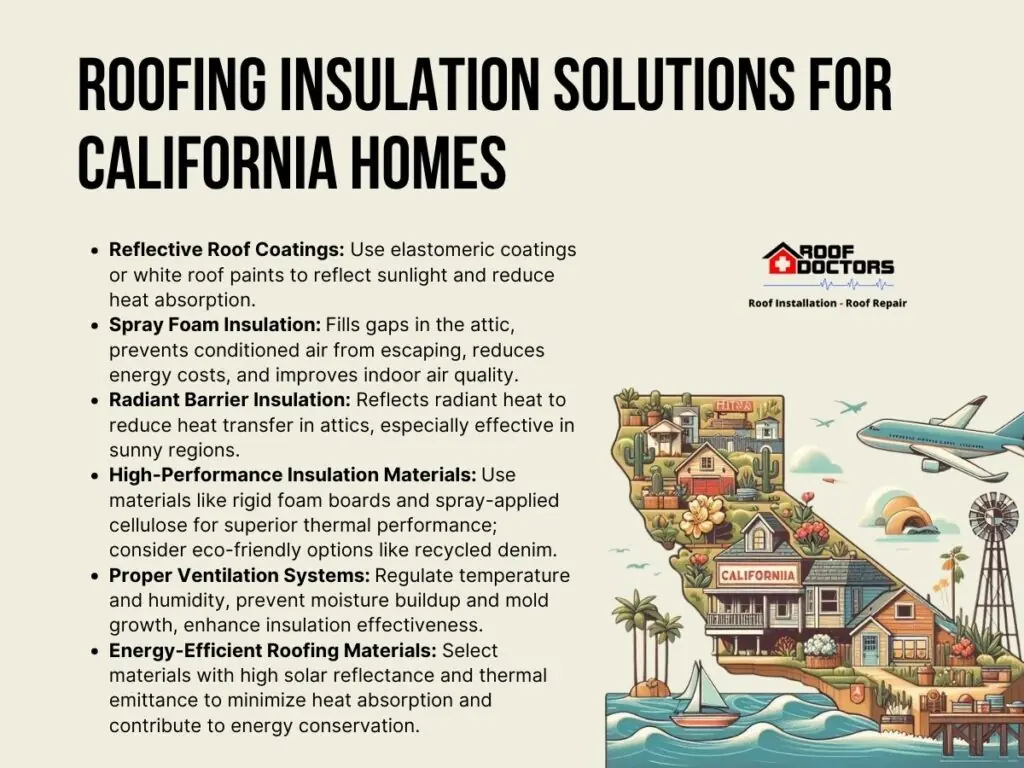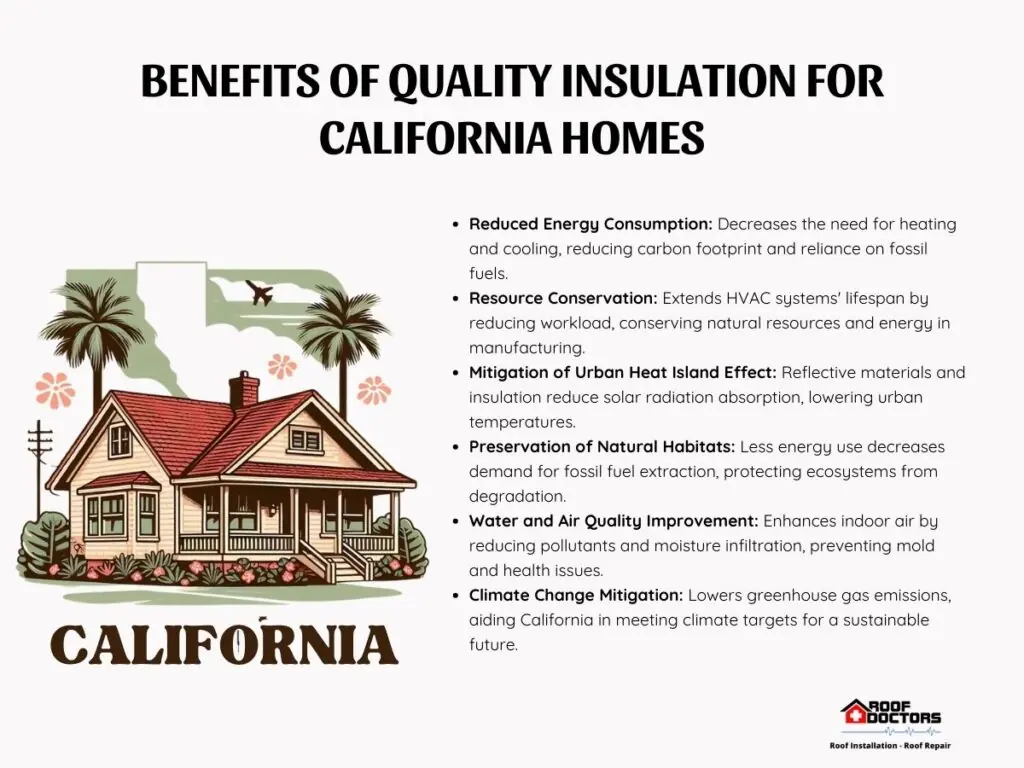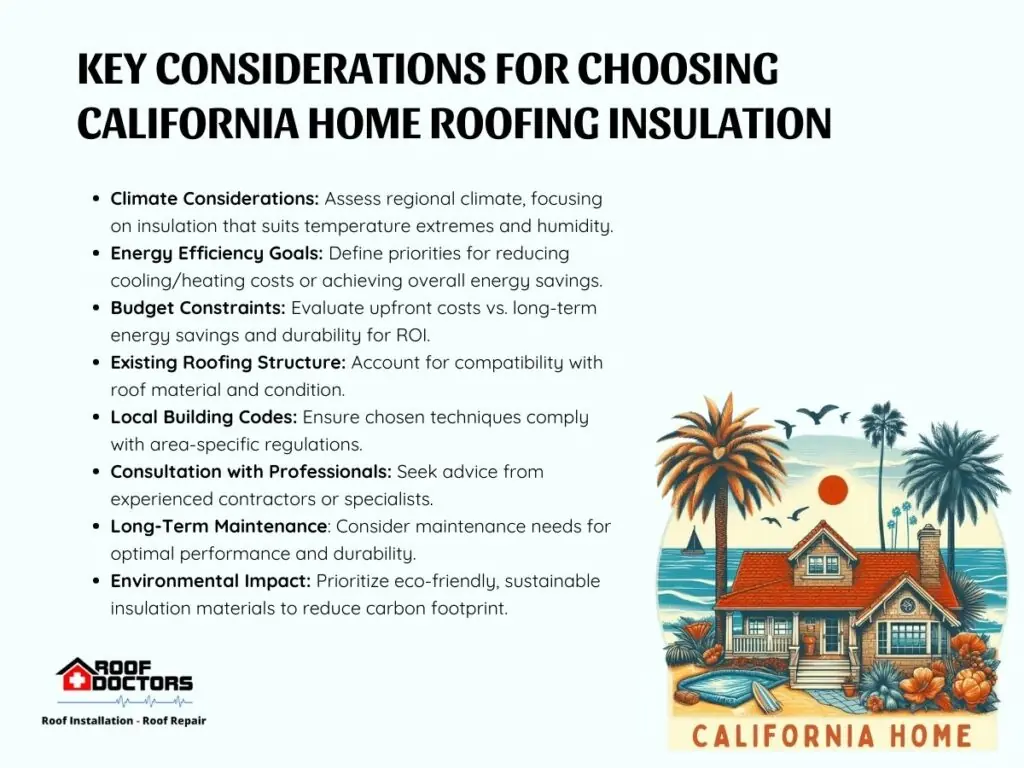Looking for the best roofing insulation tips and techniques? Roof insulation plays a crucial role in maintaining comfortable temperatures and energy efficiency within homes, especially in a climate as diverse as California’s. From scorching summers to chilly winters, Californian homeowners face a range of weather conditions, making proper insulation essential for comfort and cost savings.
In this article, we’ll explore some effective roofing insulation techniques tailored specifically for California residences. By implementing these innovative techniques, homeowners can create spaces that are not only resilient to California’s climate extremes but also contribute to a greener, more sustainable future.
Roofing Insulation Solutions for California Homes
In California, where homes face a wide range of climate conditions, from scorching heatwaves to chilly nights, implementing roofing insulation techniques tailored to these unique needs is crucial.
With a focus on blending innovation with environmental consciousness, Californian homeowners seek tailored solutions to address their unique insulation needs.
Here are several approaches specifically designed to enhance comfort and energy efficiency in California homes:

Reflective Roof Coatings
Given California’s abundant sunshine, reflective roof coatings are particularly effective in reducing heat absorption.
These coatings, often made of materials like elastomeric coatings or white roof paints, reflect sunlight away from the roof surface, minimizing heat transfer into the home.
Additionally, by keeping the interior cooler, homeowners can reduce their reliance on air conditioning during hot summer months.
Spray Foam Insulation
Spray foam insulation is highly versatile and can be applied seamlessly to fill gaps and voids in the attic space.
In California, where air conditioning is frequently used, spray foam insulation helps create an effective thermal barrier, preventing conditioned air from escaping and reducing energy costs.
Additionally, its ability to provide air sealing helps to minimize the ingress of outdoor pollutants and allergens, contributing to better indoor air quality.
Radiant Barrier Insulation
Radiant barrier insulation is specifically designed to reflect radiant heat, a significant contributor to heat gain in attics.
By installing a radiant barrier beneath the roof deck or within the attic space, homeowners can effectively reduce heat transfer into the living areas below.
In California’s sunny regions, such as Southern California, radiant barriers help maintain cooler indoor temperatures, reducing the need for excessive cooling.
High-Performance Insulation Materials
Choosing insulation materials with high R-values and resistance to moisture is essential for California homes.
Materials like rigid foam boards and spray-applied cellulose offer superior thermal performance, ensuring optimal insulation levels in attics and crawl spaces.
Additionally, eco-friendly options such as recycled denim insulation provide sustainable alternatives for environmentally conscious homeowners.
Proper Ventilation Systems
Adequate attic ventilation is crucial for maintaining a healthy indoor environment and prolonging the lifespan of roofing materials.
In California’s varied climate, balanced ventilation systems help regulate temperature and humidity levels, preventing moisture buildup and minimizing the risk of mold growth.
By promoting air circulation, proper ventilation also helps enhance the effectiveness of insulation, ensuring consistent comfort throughout the year.
Energy-Efficient Roofing Materials
Choosing roofing materials with high solar reflectance and thermal emittance ratings can further enhance the energy efficiency of California homes.
Cool roofing options, such as reflective asphalt shingles, metal roofing, or clay tiles with light-colored coatings, help minimize heat absorption and reduce the urban heat island effect.
By selecting energy-efficient roofing materials, homeowners can mitigate heat-related issues and contribute to overall energy conservation efforts.
Benefits of Investing in Quality Insulation for California Homes
Investing in quality insulation not only improves indoor comfort but also contributes to a greener, more environmentally conscious future for California and beyond.

Reduced Energy Consumption
High-quality insulation helps minimize heat transfer between indoor and outdoor environments, reducing the need for heating and cooling systems to work overtime. By requiring less energy to maintain comfortable temperatures, homeowners can significantly decrease their carbon footprint and reliance on fossil fuels, leading to lower greenhouse gas emissions.
Resource Conservation
Proper insulation extends the lifespan of heating, ventilation, and air conditioning (HVAC) systems by reducing their workload and minimizing wear and tear. This not only reduces the frequency of equipment replacements but also conserves natural resources by decreasing the demand for new HVAC units, which often require significant amounts of energy and raw materials to manufacture.
Mitigation of Urban Heat Island Effect
In urban areas, where buildings and pavement absorb and retain heat, the urban heat island effect exacerbates temperatures, especially during heatwaves. By implementing reflective roofing materials and insulation techniques, homeowners can mitigate this effect by reducing the absorption of solar radiation and lowering ambient temperatures, thus improving overall comfort and air quality in urban environments.
Preservation of Natural Habitats
Decreasing energy consumption through effective insulation reduces the demand for fossil fuel extraction and power generation, thereby helping to protect natural habitats and ecosystems from the environmental degradation associated with resource extraction and pollution.
Additionally, by minimizing the need for additional energy infrastructure, such as power plants and transmission lines, insulation contributes to the preservation of wild spaces and biodiversity.
Water and Air Quality Improvement
Quality insulation, particularly when combined with proper ventilation practices, helps maintain healthy indoor air quality by reducing the infiltration of outdoor pollutants, allergens, and moisture. By preventing mold growth and moisture-related issues, insulation contributes to a safer and healthier living environment for occupants.
Climate Change Mitigation
Perhaps most importantly, investing in quality insulation aligns with efforts to mitigate climate change by reducing greenhouse gas emissions associated with energy production and consumption.
By decreasing the carbon intensity of residential buildings, insulation helps California and other regions achieve their climate targets and transition towards a more sustainable and resilient future.
Key Considerations for Choosing California Home Roofing Insulation
Deciding which roofing insulation techniques will be best for your home requires careful consideration of several factors. Here are some tips to help you make an informed decision:

Climate Considerations
Start by assessing the climate in your region. Consider factors such as temperature extremes, humidity levels, and annual weather patterns. For instance, if you live in a hot climate like Southern California, techniques that focus on heat reflection and insulation may be more beneficial.
Energy Efficiency Goals
Determine your energy efficiency goals and priorities. Are you primarily focused on reducing cooling costs in the summer, minimizing heating costs in the winter, or achieving year-round energy savings? Understanding your goals will help you prioritize insulation techniques that align with your objectives.
Budget Constraints
Consider your budget constraints and the long-term value of different insulation techniques. While some options may have higher upfront costs, they could provide greater energy savings and durability over time, resulting in lower overall costs in the long run. Evaluate the return on investment (ROI) of each option to determine the best fit for your budget.
Existing Roofing Structure
Assess the existing roofing structure of your home, including the type of roof material, its condition, and any existing insulation. Certain techniques may be more compatible with specific roofing materials or require modifications to the roof structure. Take these factors into account when evaluating your options.
Local Building Codes and Regulations
Familiarize yourself with local building codes and regulations governing roofing insulation in your area. Ensure that the techniques you choose comply with these requirements to avoid any potential issues during installation or inspection.
Consultation with Professionals
Seek guidance from roofing contractors or insulation specialists who have experience working in your area. They can provide valuable insights and recommendations based on their expertise and knowledge of local conditions. Consider getting multiple quotes and opinions to compare different options and make an informed decision.
Long-Term Maintenance
Consider the long-term maintenance requirements of each insulation technique. Some options may require periodic inspections, repairs, or maintenance to ensure optimal performance and durability. Factor in these maintenance considerations when evaluating the overall cost and feasibility of each option.
Environmental Impact
Lastly, consider the environmental impact of different insulation techniques. Look for options that are environmentally friendly, energy-efficient, and made from sustainable materials whenever possible. Prioritizing eco-friendly solutions can help minimize your carbon footprint and contribute to a greener future.
How to Keep Your Roofing Insulation Performing at Its Best
Regular checks and maintenance are essential to ensure your roofing insulation remains effective. Inspect your insulation annually or after significant weather events, looking for moisture, mold, or areas where insulation may have shifted.
Addressing these issues quickly is crucial; replace any damp insulation and fix leaks to prevent future damage. Additionally, verify that your attic has proper ventilation to avoid moisture buildup, which can deteriorate insulation over time.
Consider upgrading your insulation to meet modern energy efficiency standards, helping extend its lifespan, enhance your home’s energy efficiency, and maintain comfort throughout the year.
Consider scheduling professional maintenance inspections of your roofing insulation at least once a year. Roofing contractors or insulation specialists can identify any issues early on and recommend repairs or improvements.
By following these maintenance tips and staying proactive in caring for your roofing insulation, you can ensure that it remains in optimal condition, providing effective thermal protection and energy savings for your home.
Conclusion
In conclusion, roofing insulation techniques tailored for California homes play a vital role in maintaining comfortable indoor temperatures, reducing energy costs, and promoting sustainability.
By implementing innovative insulation methods such as reflective roof coatings, spray foam insulation and radiant barriers, homeowners can effectively manage the diverse climate conditions of California while contributing to a greener future.
Furthermore, ongoing maintenance of roofing insulation is crucial for ensuring its optimal performance and longevity. Regular inspections, addressing water damage, sealing air leaks, and monitoring ventilation are key maintenance practices to uphold the efficiency of your insulation system.
By prioritizing quality insulation and proactive maintenance, homeowners can create resilient, energy-efficient homes that not only provide comfort and cost savings but also contribute to environmental conservation and sustainability efforts in California and beyond.


